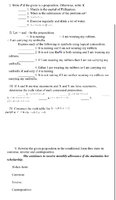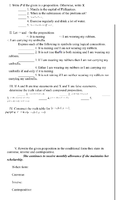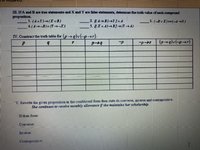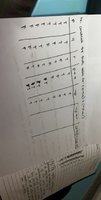You are using an out of date browser. It may not display this or other websites correctly.
You should upgrade or use an alternative browser.
You should upgrade or use an alternative browser.
Math Logic
- Thread starter Dumb@Math
- Start date
pka
Elite Member
- Joined
- Jan 29, 2005
- Messages
- 11,978
Without knowing the exact way your text defines statement it hard to judge the I above. For example some would say the 4 is an X because it in neither true or false.I’ve answered
I. 1. P 2. X 3. P 4. P 5. P
II.
1. p^¬q 2. ¬p^¬q 3. q⇒(¬r)
but I’m unsure of these answers still
In II I agree with 1. & 3. But for 2. \(\neg(p\wedge q)\).
As you should, this is the implication truth table:
\(\begin{array}{*{20}{c}}
p&q&{p \to q} \\ \hline t&t&t \\ t&f&f \\ f&t&t \\ f&f&t \end{array}\)
By looking at that table, consider these two statements.
A true statement is implied by any statement.
A false statement implies any statement.
Without knowing the exact way your text defines statement it hard to judge the I above. For example some would say the 4 is an X because it in neither true or false.
In II I agree with 1. & 3. But for 2. \(\neg(p\wedge q)\).
As you should, this is the implication truth table:
\(\begin{array}{*{20}{c}}
p&q&{p \to q} \\ \hline t&t&t \\ t&f&f \\ f&t&t \\ f&f&t \end{array}\)
By looking at that table, consider these two statements.
A true statement is implied by any statement.
A false statement implies any statement.
This is my answer to some, not yet done tho
Attachments
pka
Elite Member
- Joined
- Jan 29, 2005
- Messages
- 11,978
\(\begin{array}{*{20}{c}} p&q&r&{p \to q}&{\neg p \to r}&{(p \to q) \vee (\neg p \to r)} \\ \hlineThis is my answer to some, not yet done tho
T&T&T&T&T&T \\
T&T&F&T&T&T \\
T&F&T&F&T&T \\
T&F&F&F&T&T \\
F&T&T&T&T&T \\
F&T&F&T&F&F \\
F&F&T&T&T&T \\
F&F&F&T&F&F \end{array}\)




